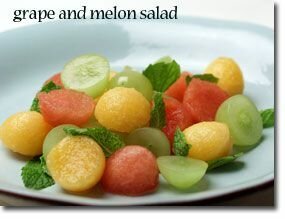If you don't know what to serve for dinner tonight ...
Take advantage of the fruits that are in season and satisfy your sweet tooth by enjoying this summer salad that takes only minutes to prepare. If you select red/purple grapes you will get the added benefit of the phytonutrient, reservatrol, which has been found to be a powerful antioxidant.

Ingredients:
- 1 lb seedless grapes
- 1 cantaloupe, scooped out with melon baller
- 2 cups of seedless watermelon, scooped out with melon baller
- 1/2 cup whole peppermint leaves
- 2 TBS lemon juice
- Mix all ingredients together. Toss with whole peppermint leaves and refrigerate for a couple hours. Remove leaves and serve.
In-Depth Nutritional Profile for Grape and Melon Salad
Healthy Food Tip
The Latest News about Watermelon
If you have ever tasted a watermelon, it is probably no surprise to you why this juicy, refreshing fruit has this name. Watermelon has an extremely high water content, approximately 92%, giving its flesh a juicy and thirst-quenching texture while still also subtly crunchy. As a member of the Cucurbitaceae family, the watermelon is related to the cantaloupe, squash, pumpkin, cucumber, and gourd that grow on vines on the ground. Watermelons generally contain dark seeds, although there are seedless varieties. Contrary to some information posted online, seedless watermelon are not the result of genetically modification but rather of hybridization.
What's New and Beneficial About Watermelon
- Alongside of tomatoes, watermelon has moved up to the front of the line in recent research studies on high-lycopene foods. Lycopene is a carotenoid phytonutrient that's especially important for our cardiovascular health, and an increasing number of scientists now believe that lycopene is important for bone health as well. Among whole, fresh fruits that are commonly eaten in the U.S., watermelon now accounts for more U.S. intake of lycopene (by weight of fruit eaten) than any other fruit. Pink grapefruit and guava are two other important fruit sources of lycopene, although in the U.S., these fruits are more often consumed in the form of juice
- Health scientists are becoming more and more interested in the citrulline content of watermelon. Citrulline is an amino acid that is commonly converted by our kidneys and other organ systems into arginine (another amino acid). The flesh of a watermelon contains about 250 millligrams of citrulline per cup. When our body absorbs this citrulline, one of the steps it can take is conversion of citrulline into arginine. Particularly if a person's body is not making enough arginine, higher levels of arginine can help improve blood flow and other aspects of our cardiovascular health. There's also some preliminary evidence from animal studies that greater conversion of citrulline into arginine may help prevent excess accumulation of fat in fat cells due to blocked activity of an enzyme called tissue-nonspecific alkaline phosphatase, or TNAP.
- If you've gotten used to thinking about the juicy red flesh at the center of a watermelon as its only nutrient-rich area—and far more nutrient-rich than the more lightly-colored flesh that is farther out near the watermelon rind—it is time to change your thinking. In a recent study, food scientists compared the nutrient content of flesh from different parts of a watermelon: flesh from the center, the stem end, the blossom end (opposite from the stem), and the periphery (the part nearest to the rind). What they've discovered were impressive concentrations of phenolic antioxidants, flavonoids, lycopene, and vitamin C in all of these different areas. The exact distribution of nutrients was also highly dependent on the variety of watermelon. But there was no area in any of the watermelon varieties that came out badly in terms of nutrients, and in many of the watermelon varieties, the flesh's outer periphery contained impressive concentrations of most nutrients.
- Recent studies have confirmed the nutritional importance of allowing a watermelon to fully ripen. For example, research has shown that the biggest jump in lycopene content occurs at the time when a watermelon's flesh turns from white-pink to pink. Yet when that flesh continues to ripen, resulting in a color change from pink to red, the lycopene content becomes even more concentrated. Prior to ripening, when the flesh of a watermelon is primarily white in color, its beta-carotene content is near zero. Even when allowed to ripen to the white-pink stage, a watermelon still contains very little of its eventual beta-carotene content. But as it moves from white-pink to pink to red, the beta-carotene content of a watermelon steadily increases. Like lycopene and beta-carotene, total phenolic antioxidants in a watermelon also increase consistently during ripening, all the way up until the appearance of fully red flesh. The bottom line: eating a fully ripe watermelon can really pay o ff in terms of nutrient benefits. Please see our section called "How to Select and Store" to learn about determining a watermelon's ripeness before you purchase it.
Health Benefits
Watermelon provide numerous health benefits including:
- Antioxidant support
- Anti-inflammatory benefits
- Cardiovascular benefit
Nutritional Profile
Watermelon is an unusual fruit source of the carotenoid lycopene and a
rich source of phenolic antioxidants. Watermelon contains cucurbitacin
E, a triterpene anti-inflammatory phytonutrient, and unusual amounts of
the amino acid citrulline. Watermelon is an excellent source of
immune-supportive vitamin C. It is also a very good source of
free-radical-scavenging vitamin A (in several carotenoid forms, and
especially in the specific form of beta-carotene). In addition,
watermelon is a good source of heart-healthy potassium and magnesium.
For more on this nutrient-rich fruit, including references related to this Latest News, see our write-up on watermelon.

No comments:
Post a Comment